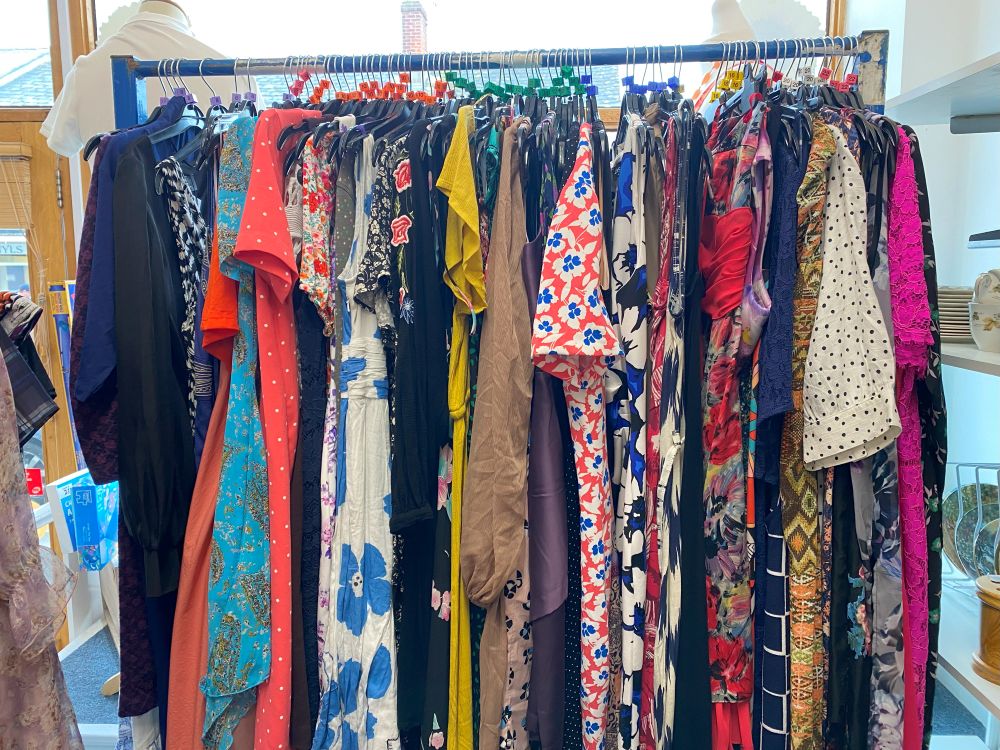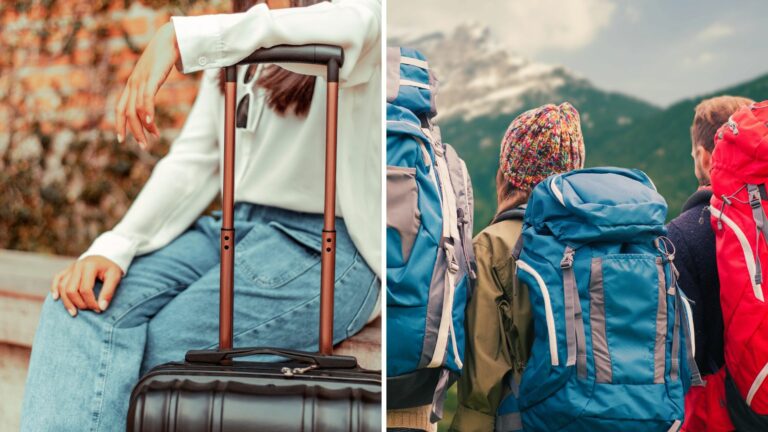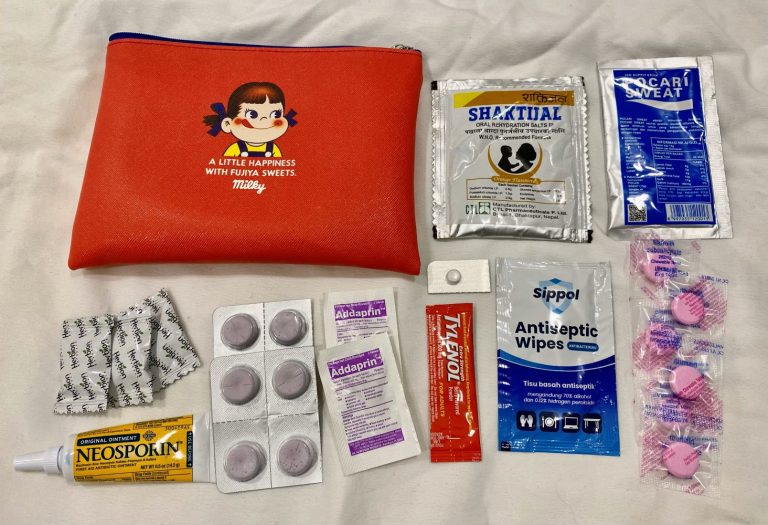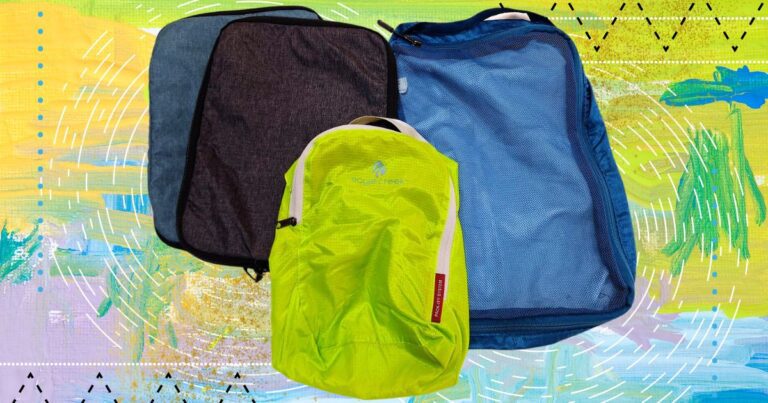What Materials Work Best for Your Travel Wardrobe?
Before I set off on my life of full-time travel, I spent about a year worrying about what to pack. Specifically, I wasn’t sure what sort of clothing I should take and I did a LOT of research before deciding on my first wardrobe.
For long-term nomads, the general advice is to buy clothing items that wash well by hand, can be worn multiple times before smelling, and dry quickly. They get recommended specific brands that do technical travel clothing, and they say to get dark colors (that hide stains). Most of those brands tend to do clothes within a few small style ranges, mostly athleisure…
So basically, people tend to end up with the same few brands in their backpacks, in blacks and browns, looking like they’re going hiking every day– or at the very least to the gym.
While I adore certain outdoor brands and love their clothes, I personally don’t want to show up to a European B&B looking like I just came down the mountain if I’m not planning to actually do any major outdoor activities. I’m more of a city traveler, anyway, and tbh I’ve felt very awkward in some urban settings with my obviously athletic shoes and sporty fleece jacket. (Not everywhere is Seattle.)
At the same time, I’m not prepared to fork over $200 for a single shirt just because it’s a brand name.
Really, the brand doesn’t matter as much as the MATERIAL, the color and the style of an item.
With that in mind, I’m determined to build up a good travel wardrobe for the next leg of my adventure.
This is the first post in a series of guides about how to build a travel wardrobe with intention. In this post, I’ll talk specifically about materials: which fabrics travel well, how to find clothing in those fabrics that look great, and some suggestions for where to find clothes in specific fabrics.
Just Gone Wandering is supported by readers! This post contains affiliate links. If you click on a link and buy something, I get a small percentage at no extra cost to you. Your support helps keep this blog running— thank you! Read full disclosure here.
Which material is the best for travel clothes?
Okay, so there’s several things I try to aim for when I’m buying travel clothes:
- It needs to travel well, i.e. not wrinkle, fold down small, and holds up to handwashing every week
- It needs to be comfortable to wear for hours on end
- It needs to not be SO expensive that if I lose it or it wears out, I’m not devastated by the loss
Every piece may not be every thing, but I try to have at least two overlaps.
So maybe something is comfortable and cheap, but it doesn’t last (cotton t-shirts) or something is slightly uncomfortable and it’s expensive, but it travels well (merino wool bras).
Keep reading: Female Digital Nomad Packing List (Carry-On Only)
Keeping all that in mind, here’s what I think are the BEST materials for travel clothes. Not in any particular order:
1. Linen

Linen (100% linen and not linen blend) is cool in hot humid weather, very lightweight, and can pack down fairly small. On the other hand, it wrinkles a lot and wears out fairly quickly if you get the cheap thin kind.
I tend to keep my linen pieces to things like tops and dresses. I got a great linen top at TJ Maxx last year (it’s actually a swimming cover-up) and it held up really well in Malaysia and Vietnam. I sweated through it, but it didn’t feel uncomfortable and it dried quickly. Yes, it wrinkled, but it’s a casual-looking fabric so it’s not terrible to have wrinkles now and then.
Note: I find that some linen blends don’t breathe very well. If you’re going for a blend, I recommend linen-cotton or some other natural fiber that’s breathable.
Also note: linen pants tend to be VERY thin and either see-through or they wear out in the rear very quickly. They are super comfortable, though!
2. Merino wool

This is touted everywhere as the Big Thing in travel clothes, and for good reason.
It dries quick, so you can handwash a shirt and it’ll dry overnight (even in humid places!). It’s lightweight, doesn’t wrinkle, and can pack VERY small. And because it has anti-microbial properties, you can wear it multiple times before it starts to smell, cutting down your need to do laundry!
I’ve worn merino wool shirts in Southeast Asia’s humidity, sweated through it all day, and felt perfectly comfortable because it wicked away the sweat from my body and dried before the underarms got clammy. I’m actually fairly sensitive to normal wool and can’t wear it on my bare skin, but the finer merino wool blends don’t feel as itchy– and after washing them a few times they’ve become more comfortable to wear.
Though merino wool tends to be fairly expensive, there’s different quality levels (and blends) available and you can find some very nice things for under $30 USD. I recommend getting at least a merino wool sweater and a bra or two, and perhaps some socks.
Note: Merino wool is more delicate than some other materials, so it’s best to handwash and lay flat to dry. This can be annoying to deal with, but since you only need to wash them maybe once a week if that, it’s not too bad.
I’ve heard some people had holes develop in some of their tops after heavy use. I haven’t had that issue, but then I don’t wear the same top every day. My one merino wool shirt HAS started to look a little worn out after a year of travel, but it’s not terrible. Likewise, my merino wool sweater from Unqilo has held up VERY well for nearly 3 years of travel (of course I didn’t wear it much when I was in Southeast Asia for a year, but still).
3. Cotton

The most comfortable fabric and the best-priced, but unfortunately it just does NOT last if you’re in a hot/humid climate. During my travels around Southeast Asia, I got some nice t-shirts from Uniqlo and took them to Singapore and Indonesia. They were literally falling apart after two months!
Not to mention that cotton shirts feel horrible when you’re sweating. The underarms never dry, and the sweat marks are super obvious.
And if you’re handwashing your clothes, cotton doesn’t dry quickly, especially in humid locations. And it’s one of the heaviest fabrics, which can quickly increase your luggage’s weight.
On the other hand, if you’re traveling mostly to temperate climates, have access to a washing machine and don’t care about luggage weight, then cotton is perfectly fine! Personally, I always have a cotton shirt or two to use for pajamas, as I find that most comfortable.
Related: Sleep Better While Traveling: Nighttime Tips for Stress-Free Rest
4. Silk
Maybe the most luxurious fabric on this list! Silk packs down tiny, looks elegant, is good in hot or cool climates, and is pretty good at staying un-wrinkled. Of course, it’s also pretty expensive and relatively delicate (you can’t just drop off your silk PJs to the local laundromat).
I actually don’t have any silk clothing items yet, but I do have a silk sleeping bag liner that I love. It’s on my to-buy list because I think it’d make for a wonderful alternative to linen when I want to look slightly fancier.
However, I would NOT wear silk in hot/humid climates where I expect to sweat a lot, as I think sweating into silk breaks it down faster.
5. Polyester
Okay, generally polyester is a bad choice in daily life (for me) because it’s uncomfortable– stiff, not breathable, and cheap-feeling. But most athletic/outdoor clothing items are either polyester or have polyester blend in them, because it dries quick, hold up well to high-energy activities like hiking, and it’s pretty inexpensive!
Most of the clothes with UPF protection in them are made from polyester or nylon, too. If you’re looking to get specialized sun gear, it’s probably polyester.
Personally, I find most polyester clothes very sweaty in places like Southeast Asia because they don’t breathe! I struggled so much with my beloved Columbia long-sleeve shirts in Indonesia and Malaysia, because they were so stuffy. However, the sun protection is great!
Plus, if you’re not traveling in humid climates, polyester is much more tolerable. Also, some special weaves (or whatever) of polyester are more breathable than the regular stuff, like Uniqlo’s Cool Tech line.
All that said, I find that polyester shirts tend to smell very quickly. I can’t ever re-wear a shirt after a day out in one, not like I can with merino wool. And eventually I couldn’t even get the stink out, even with using a proper washing machine.
Related: How to Fix Smelly Teva Sandals
6. Cashmere
This is another type of wool and I don’t think I’d wear a cashmere shirt in the heat. But it’s great for cold climates! You get very warm very quickly, and it’s not too bulky.
I found a great cashmere cardigan at the thrift last year and took it with me to Japan, where it was still freezing for a month or so before the cherry blossoms came. That cashmere cardigan was warmer than my merino wool sweater and much more comfortable, and about 2/3 smaller than my fleece jacket of a similar warmth.
Cashmere is also very delicate, so you wouldn’t necessarily want to wear it every day for years. But for a few months while traveling in cooler climates…it’s great!
Where to Buy Travel Clothes in Specific Materials
When shopping for a new wardrobe, it’s easy to go overboard and buy a bunch of stuff you don’t need. In fact, I highly suggest NOT going all out and buying a new set of merino wool clothes– at least not before you even try it to see if it’s what you want. Maybe you’re super allergic to wool and can’t even wear merino wool! Do you really wanna spend $50 for a shirt you can’t even wear?
Plus you DON’T have to buy clothes from travel-adjacent or outdoor companies. Any linen shirt can be good for travel, if it’s made well.
Here’s my suggestions:
Go shopping at thrift stores! You can find amazingly-priced clothes here, for a significant savings. I once found a cashmere sweater at a thrift store for only $3!
It might take a while to figure out how to look through the clothing racks quickly, and how to be able to tell what’s wool and what’s acrylic just by touch. But the more you practice the fast you’ll be able to find cool stuff for your wardrobe.
Shop on secondhand websites like eBay, Poshmark and Thredup. It’s very much like thrifting, but a little easier because you can just search by whatever keyword you want. I tend to search by color, size and material and ignore the brand (unless it looks like a cheap Chinese knock-off).
Check out sales and clearance sections at stores. I recommend going in person if you can, as usually the prices are much lower than the “sale” prices online. Plus you can try things on easier and see if something itches or not.
Go to markdown stores like Marshall’s or TJ Maxx. You can often find nice clothes there– mostly blends, true, but sometimes you can get 100% linen or wool for a decent price.
You can also wait to buy things until you’re there, depending on where you’re going and what size you need. Locals want to be comfortable just as much as you, so they’ll have the right materials for whatever clothes work best for their location.
Related: Japanese Mall Fashion (Photo Collection)
Whatever you do, I recommend focusing on the material (and color/style) rather than the brand. This’ll give you some great options you might’ve missed because you were focusing on “travel brands.”
Save to Pinterest
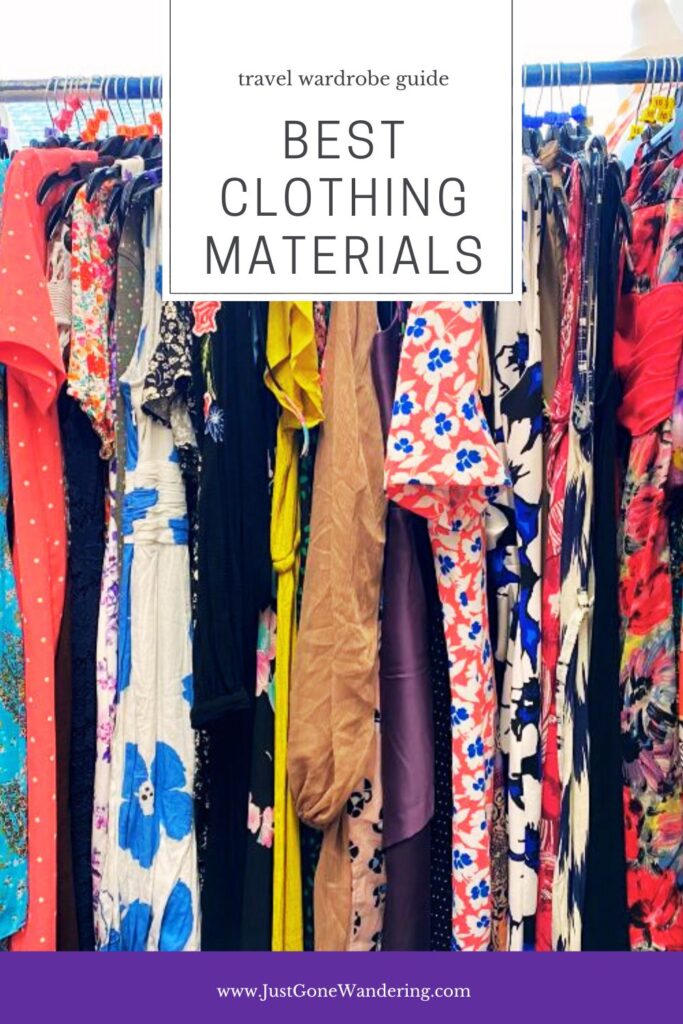
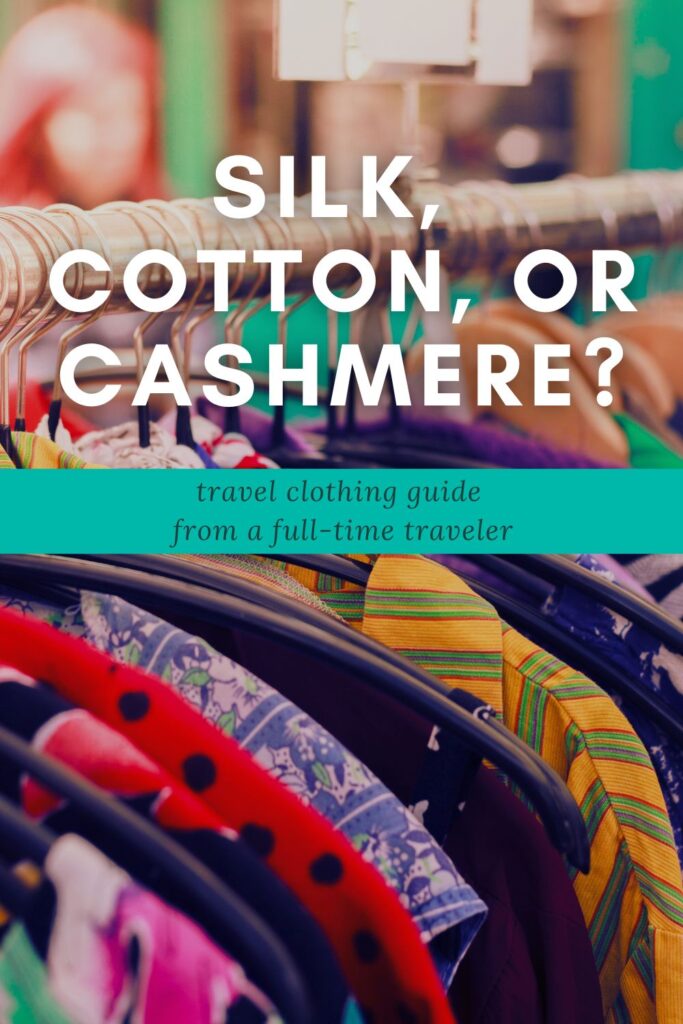
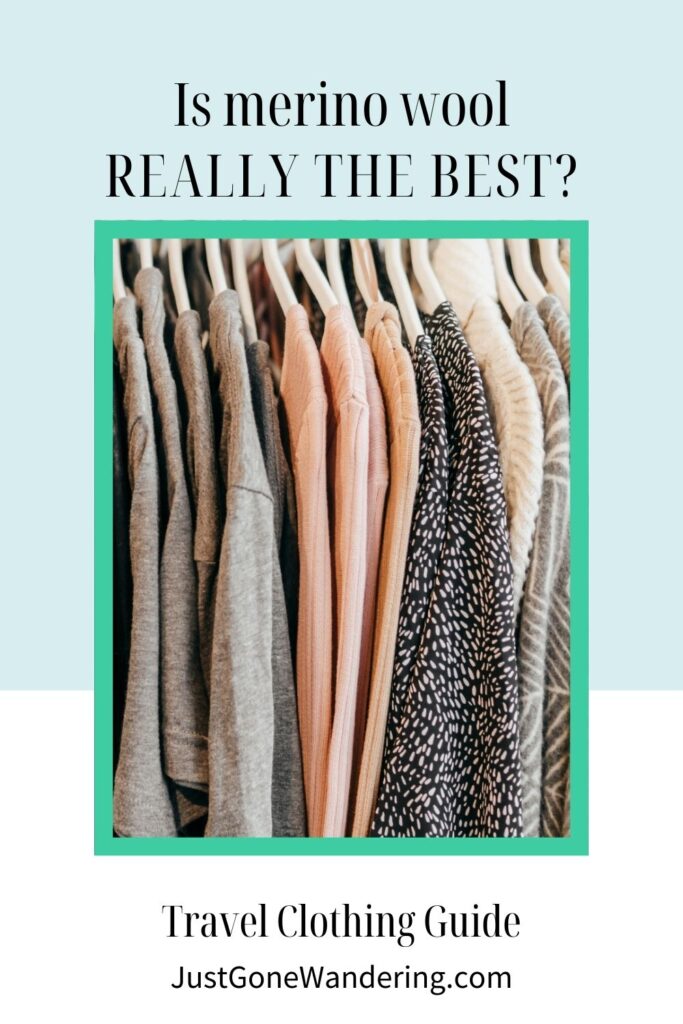
Best Travel Resources
- 👩💻Stay organized with the Deluxe Travel Planner Spreadsheet
- 🛌Search Hostelworld for budget stays
- ✈️Search SkyScanner for discounted flights around the world
- 😺Join TrustedHousesitters and do petsitting in exchange for accommodation
- 💳Carry Chase Sapphire Preferred for a travel-friendly credit card
- 📱Use Airalo for eSIMs around the world
- 🚙Check DiscoverCars for international car rentals
- 👩💻Snag ExpressVPN to stay safe while browsing the web
- 🧑⚕️Sign up with VisitorsCoverage for trip insurance


